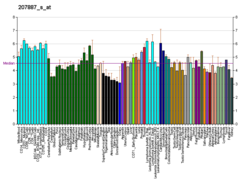The calcitonin receptor (CT) is a G protein-coupled receptor that binds the peptide hormone calcitonin and is involved in maintenance of calcium homeostasis, [5] particularly with respect to bone formation and metabolism. [6] [7] [8]
Contents
CT works by activating the G-proteins Gs and Gq often found on osteoclasts, on cells in the kidney, and on cells in a number of regions of the brain. [9] It may also affect the ovaries in women and the testes in men.
The function of the CT receptor protein is modified through its interaction with Receptor activity-modifying proteins (RAMPs), forming the multimeric amylin receptors AMY1 (CT + RAMP1), AMY2 (CT + RAMP2), and AMY3 (CT+ RAMP3). [10]
Preclinical studies have suggested that dual amylin and calcitonin receptor agonists may be more effective than amylin receptor agonists for obesity and type II diabetes. [11]






